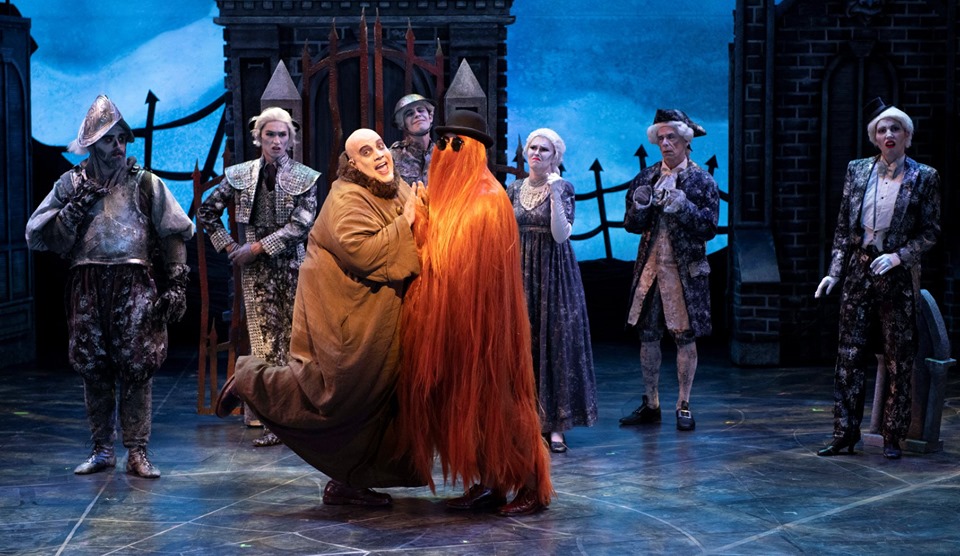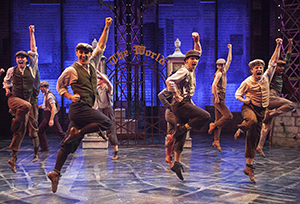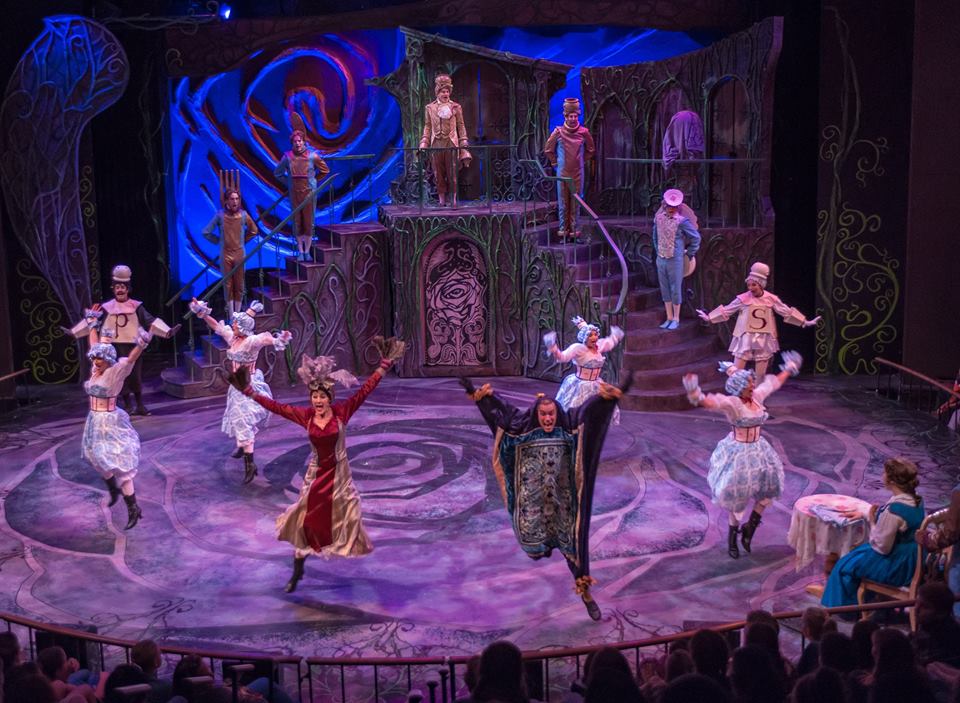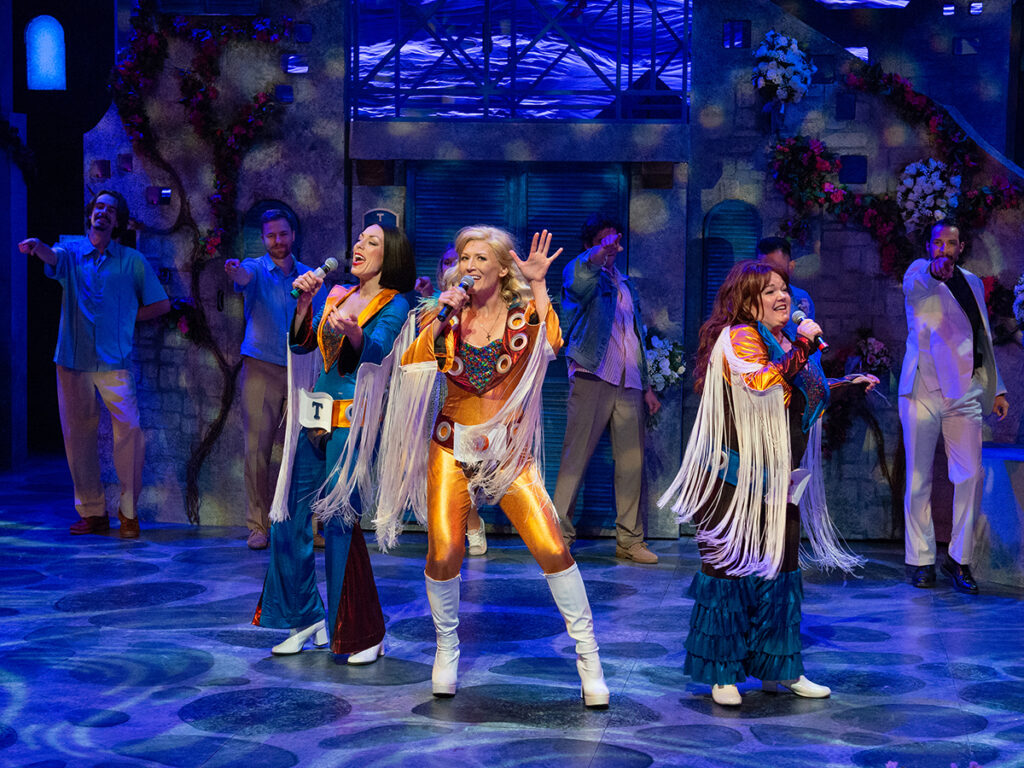NPR Ed has just published a database of the most popular high school plays and musicals in the U.S. for 2019. Upon reading this list, I realized that I have designed all but two of these musicals, so I thought I’d share a few experiences I encountered with each. I’m only touching on the musicals, but here’s the link to the original article if you’d like to follow along at home, and also read about the most popular high school plays in 2019.
Alright, here we go! (I feel like David Letterman…digital high-five if you get the reference.
#10 Shrek, The Musical & The Wizard of Oz
No, this is not a weird mashup (but that would be hilarious, someone write this right now). These two musicals have tied for 10th place. I’ll start with Shrek.
I loved this musical, it was so much fun, and it’s a great option for high school casts. The biggest hurdle I faced with this show was makeup. As you probably know, Shrek is green, Fiona turns green, and donkey is grey. There’s also a giant dragon puppet. Shrek almost never leaves the stage. He also has a pretty complicated costume and heavy face makeup, so my first piece of advice is to double-mic Shrek.
Our Shrek wore a little beanie that was never removed, so I integrated microphone elements into that beanie. I asked the costumes department to sew a few small, elastic loops into the inside of the beanie, and threaded two microphone elements (which were Hellermaned together) through the inside of the beanie that popped out the front, landing in a nice little forehead position. Shrek’s makeup was airbrushed on him each day, and our costume department was nice enough to give me a little bit of that green so that I could paint the elements in the same color.
This paint job had to be touched up about 2 times a week. Also, if your Shrek is wearing a fat suit, I recommend placing his transmitter on the outside of that rig. Depending on the transmitter and the fabric of the suit, they can have some difficulty cutting through all of those layers. Fiona is a little easier, but has one very important scene to consider—her transformation scene. The transformation, including green makeup and prosthetics, needs to happen super quickly.
Since I could foresee green makeup flying all over that microphone element, I made the decision to have a second element prepped and ready for this quick change. This element was also painted in the Shrek green makeup. Human Fiona wore her element in a forehead position that ran under her wig (but not under the wig cap, which I would normally do), and during the quick change, the Human Fiona wig and element would come off, disconnect from the transmitter, her face was quickly painted green, and then the green element would replace the previous one and run under Ogre Fiona’s wig. My A2 would handle all of the element work, including holding the capsule in place while the wig was being attached, and dressers took care of the rest of the change around the A2.
Our Donkey wore a head-to-toe bodysuit, so running his element under the hood of the bodysuit to the top of the forehead was my preferred method. Finally, the dragon. The dragon is a puppet that is manipulated by several operators. We had a separate actor voicing the dragon for her very fabulous song, Forever. Our vocalist was visible onstage, so I decided to match her R&B goodness with a gold-grilled handheld wireless mic.
#9 Into The Woods
I have never designed this show, but I really want to, so if you’re reading this blog and you are a producer, call me.
# 8 Seussical
I designed this show over a decade ago, and it was for a high school company. In fact, I’m willing to bet that 85% of the companies producing this show nowadays are middle and high school companies. My biggest challenges on this show were the gear and personnel.
There are 12 principals, and an endless possibility for the ensemble. I think my total cast size was between 50-60, plus we had an 18 piece orchestra. The school chose to provide their own gear as opposed to renting from my theater, so I had to work with what they had.
For the orchestra, I was given 5 pencil condenser microphones, 1 SM57, 1 SM58, and a handful of DI boxes. Luckily, I had enough DI boxes for guitars, keyboards, and bass. I ended up mic’ing sections instead of individual instruments, as would normally be my choice. So, I put a condenser microphone on the reed section, brass section, string section, percussion section, and used one as overhead for the drumset. I used the 57 on the snare and the 58 on the kick. Some careful EQ really helped with this skimpy choice of mics.
For actor mics, I was given 12 wireless transmitters, 9 lavs, and 3 choir mics. Yep, you read that right. Remember, this is a cast of about 55. I put all 12 transmitters on the principals, and 7 lavs permanently on those principals that had the most stage time. Now, I really, REALLY hate microphone swapping and avoid it whenever possible, but for this show, it just had to be done. Luckily we were only swapping 2 lavs between actors. I put together a mic swap sheet and walked my high school student A2 through the process step by step.
Since I had 12 transmitters, the packs could all stay on their dedicated actor, and the A2 would just have to attach the lav as needed. For the ensemble, I had to bargain with the director a bit. The ensemble blocking was all over the place, and the director was hoping I would just hang those 3 choir mics evenly distributed over the stage, and they would produce the same sound as the principals in lavs. I told her that one choice mic hanging 6 ft over the head of one tiny 13 year old was not going to give her the sound she was looking for, but 3 choir mics positioned in one area over a group of 40 13 years olds would get her closer. She was not willing to forfeit all of her blocking and make the ensemble completely stationary, so we chose 3 locations where large groups of the ensemble would land for musical numbers, and I hung a choir mic over each location. On the rare occasion that an ensemble member had a pop-out solo, we made sure they were standing next to a principal so that we could get a little more gain from that open mic.
I also had a high school student mixing at front of house, so I preprogrammed the show for him, made it as user-friendly as possible, and walked him through the scenes one by one. Designing this show was the first time that I realized student production does not necessarily equal easy. Given all of the constraints and restrictions, I’m happy with the way the show turned out, and I DEFINITELY learned a lot from that production.
#7 Little Shop of Horrors
Again, I have never designed this show, but it’s one of my FAVES, so if you need a sound designer for this, you know who to call!
#6 Newsies
I did this show a few years ago, and I absolutely loved it. The cast was phenomenal, the music was great, my biggest and only enemy during this production was sweat. If you don’t know the show, it basically features a group of stupidly talented dancing newsboys. If the show is done right, and I’d like to think ours was, they are dancing their little hearts out for the majority of the show. That means lots and lots of sweat.
My regular transmitter protection protocol is to put the transmitter in a non-lubricated condom rolled all the way up with a cotton ball sitting between the connector and antenna. Most of the transmitters were in a neoprene mic belt, which is super protective against a sweaty body. Because only a few of our mic belts had flaps on them for extra transmitter security, the excessive amount of dancing would sometimes cause my cotton balls to jump out of the mic belt, and onto the ground. I decided to add a rubber band around the length of the transmitter to hold the cotton ball in. In a few cases, I found that transmitters were still getting sweated out, despite the neoprene mic belt and latex protection. For these few microphones, I added a layer of glad wrap around the transmitter. The sticky seal on this wrap really helps to keep the transmitter dry and happy. Remember to let the seal extend above the microphone connector and antenna. I then put the glad-wrapped transmitter in the un-lubricated condom and added the cotton ball.
I also had a few situations in which the microphone element that was rigged over the ear of the actors picked up an extreme amount of sweat regularly. One of my favorite solutions for this issue is to add a tiny, rubber washer to the element that sits just above the capsule. The idea is that the washer will help distribute accumulated sweat out instead of down into the capsule. I got mine in a pack of 100 for less than $10 from McMaster-Carr.
#5 Mary Poppins
The most important thing to remember for this show is that Mary Poppins=FLYING! This is important to remember because
#1: In addition to her heavy costume, corset, and mic belt, Mary Poppins also wears a flying harness.
#2: Depending on where her take-off and landing zones are, you may not have as much off-stage access to Mary as you might like.
This becomes problematic when microphone troubleshooting becomes necessary. There are also very few moments that Mary Poppins is off stage, so I decided to double mic her. I originally had her two transmitters on her mic belt under her corset, but I found that their antennas were having a difficult time cutting through all of the layers of heavy fabrics. It was also quite uncomfortable for our Mary Poppins, given the extra belt of the fly harness.
I ended up moving one transmitter to inside her wig, and the other clipped to the front, outside of her corset. The wigged transmitter was a Shure UR1M. I think this position would have been too uncomfortable with anything other than a micro-transmitter. The costume department helped by making a wig cap sandwich to help keep the transmitter secure, yet still accessible. The actor playing Mary Poppins would pin curl her hair and wear a wig cap
#1 over the curls. On top of this wig cap was an added pocket for the transmitter. She then added a wig cap
#2, which was held on with 2 hairpins. The wig was then applied. There were many times throughout this run when we had to switch to the backup mic mid-show, so I’m glad we made the choice to double mic.
#4 Beauty and the Beast
This is a BEAST of a show! As we all know, there are many enchanted objects that live in the beasts castle. If the mouth and/or majority of the face are obstructed by costumes, my advice is to build the microphone into the costume in such a way that it has better access to the mouth.
I chose a forehead microphone placement for our beast, but his hair/mane was worn so low on his forehead that it became necessary to place the capsule of his mic just above his brow line, which was fine, just required a bit of a different EQ. Most productions, including ours, feature a Beast double for the final battle between Beast and Gaston. This is to facilitate the transformation of Beast to Prince.
There are several Beast lines that occur while the double is on stage, so as not to let on about our theatre magic, I chose to record those lines and have them played back. There is a lot happening in this scene, and it should be pretty dark and scary, so there’s no need to worry about lip sync lining up. We had a second microphone element mounted on an ear rig for Beast’s transformation to the Prince, so during that costume change, we switched to the second element.
#3 The Little Mermaid
I am currently contracted to design this show, but will not begin the process for another few months. So far, my biggest concern is, again, flying. While our production does not feature true flying, we will be using a few silks and ropes that actors will climb and swing on. They will be harnessed, so I will be thinking of careful transmitter placement to guard against the actor or the equipment getting damaged.
# 2 Mamma Mia!
Mamma Mia! seems like it would be a pretty straightforward show, and it is. The thing that required some extra thought for me was the large number of backup vocals. We did not use pit or offstage singers, so I chose to record our ensemble singing all of the backup vocals. Our production also features lots of dancing, so we did record some ensemble vocal overdubs to playback and sweeten those very heavy dance moments.
The curtain call of this show features what is basically an Abba concert. For this moment, I had originally planned on our music director and his assistant to be wheeled out on stage while playing live keyboards, but because of a personnel change very close to the opening of this show, we had to scrap that idea. I’m telling everyone this tidbit because I’m hoping someone out there is able to up the stakes of this glimmering disco concert! I also insisted that the main six use handheld wireless microphones during the concert, and we even managed to add some blingy handle covers for good measure!
#1 The Addams Family
It seems only right that this show is in the number one slot, it is definitely in my top three favorite designs. If I’m being perfectly honest, I didn’t encounter too many issues I needed a creative solution for on this show. I did get to play with a few fun effects, though. I don’t know if this is the typical casting, but our Cousin It also played the monster in Pugsley’s room.
Both of these characters featured a costume that completely covered the actor’s head. The monster costume was literally built on top of a motorcycle helmet worn by the actor. As you can imagine, these are not ideal microphone situations. I chose to cover the echo chamber that these pieces created with effects. Since both characters made only sounds and not words, I was able to be pretty heavy-handed with the effects, as I was not worried about intelligibility or tedious balance.
For both characters, I used a dual pitch. I dialed both of It’s pitches extremely high, and both of the monster’s pitches extremely low. We gave the actor some time during tech to experiment with different sounds to see what could be produced through these effects. The outcome was very exciting, and a crowd favorite!
The opening number of the show features ensemble “ah’s,” which were sung offstage for our production. To give this an “other-worldly” feel, I basically drowned them in a large chamber reverb with a shockingly long 9-second decay. The same effect was applied to the women’s ensemble final “ah’s” in The Moon and Me.
Whatever musical you may be working on, remember that you do not always have to be beholden to budget, inventory, or personnel. Creative solutions are out there, you just have to think outside the box. Also, remember your community if you get stuck! There is nothing wrong with reaching out to your hive, analog or digital, to discover just the right trick!



